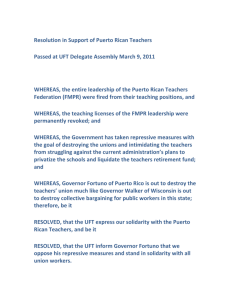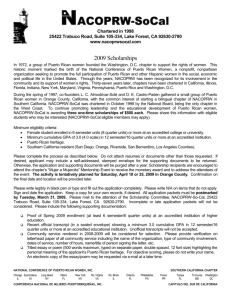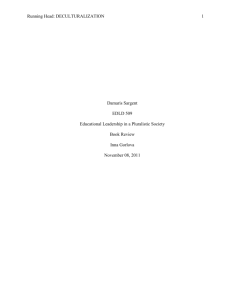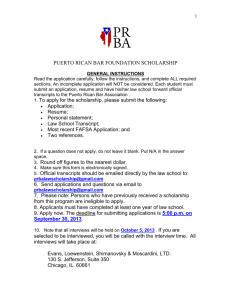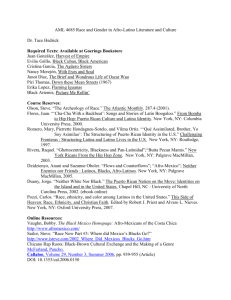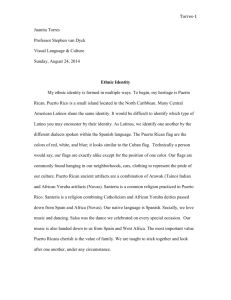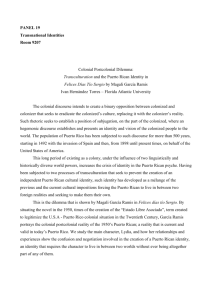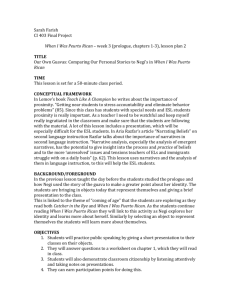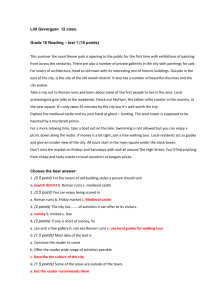File
advertisement
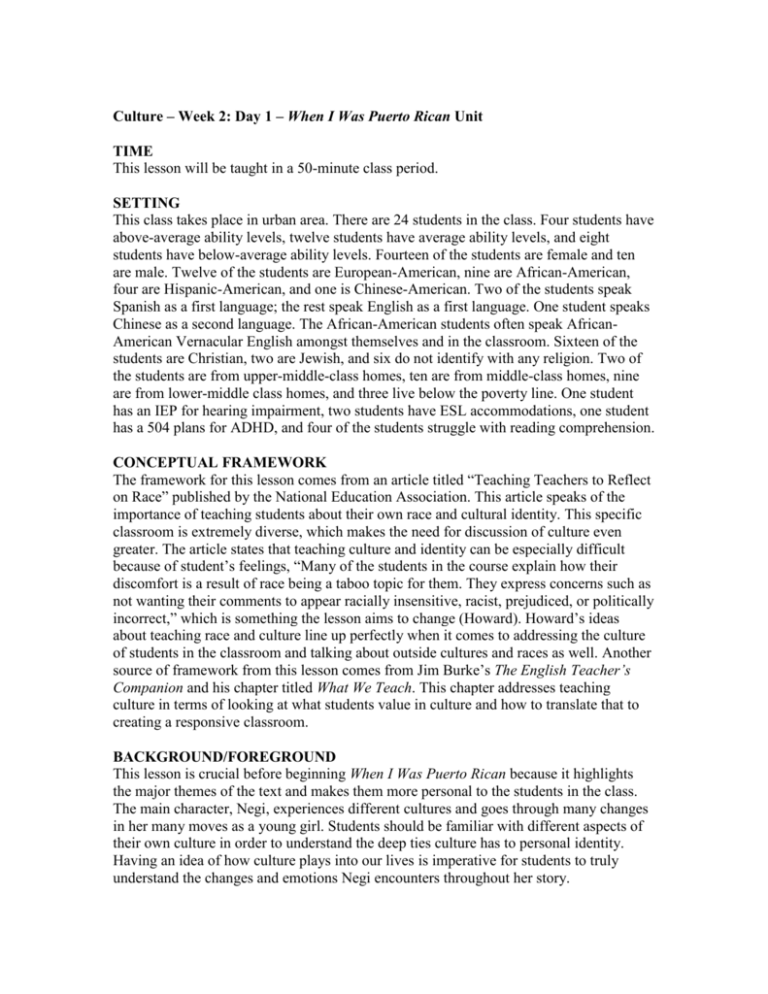
Culture – Week 2: Day 1 – When I Was Puerto Rican Unit TIME This lesson will be taught in a 50-minute class period. SETTING This class takes place in urban area. There are 24 students in the class. Four students have above-average ability levels, twelve students have average ability levels, and eight students have below-average ability levels. Fourteen of the students are female and ten are male. Twelve of the students are European-American, nine are African-American, four are Hispanic-American, and one is Chinese-American. Two of the students speak Spanish as a first language; the rest speak English as a first language. One student speaks Chinese as a second language. The African-American students often speak AfricanAmerican Vernacular English amongst themselves and in the classroom. Sixteen of the students are Christian, two are Jewish, and six do not identify with any religion. Two of the students are from upper-middle-class homes, ten are from middle-class homes, nine are from lower-middle class homes, and three live below the poverty line. One student has an IEP for hearing impairment, two students have ESL accommodations, one student has a 504 plans for ADHD, and four of the students struggle with reading comprehension. CONCEPTUAL FRAMEWORK The framework for this lesson comes from an article titled “Teaching Teachers to Reflect on Race” published by the National Education Association. This article speaks of the importance of teaching students about their own race and cultural identity. This specific classroom is extremely diverse, which makes the need for discussion of culture even greater. The article states that teaching culture and identity can be especially difficult because of student’s feelings, “Many of the students in the course explain how their discomfort is a result of race being a taboo topic for them. They express concerns such as not wanting their comments to appear racially insensitive, racist, prejudiced, or politically incorrect,” which is something the lesson aims to change (Howard). Howard’s ideas about teaching race and culture line up perfectly when it comes to addressing the culture of students in the classroom and talking about outside cultures and races as well. Another source of framework from this lesson comes from Jim Burke’s The English Teacher’s Companion and his chapter titled What We Teach. This chapter addresses teaching culture in terms of looking at what students value in culture and how to translate that to creating a responsive classroom. BACKGROUND/FOREGROUND This lesson is crucial before beginning When I Was Puerto Rican because it highlights the major themes of the text and makes them more personal to the students in the class. The main character, Negi, experiences different cultures and goes through many changes in her many moves as a young girl. Students should be familiar with different aspects of their own culture in order to understand the deep ties culture has to personal identity. Having an idea of how culture plays into our lives is imperative for students to truly understand the changes and emotions Negi encounters throughout her story. Understanding themselves better will lead students to deeper analytical levels when it comes to writing and discussion. OBJECTIVES Students will begin to have an idea of the issues or struggles when entering a new culture Students will reflect on their own culture and identity and how it has shaped them MATERIALS Cultural Differences video Journals Pens/pencils When I Was Puerto Rican Large sheets of paper Markers Writing assignment PREPARATION Find a video on foreign culture compared to United States culture Create journal questions Create personal cultural family tree Create writing assignment PROCEDURE Introduction (10 minutes): Teacher will introduce the upcoming unit including introducing When I Was Puerto Rican and the themes of culture/identity. Students will watch National Geographic video on cultural differences in the United States (4:58) http://www.youtube.com/watch?v=BT0kzF4A-WQ Mini-Lesson (15 minutes): After watching the video, students will be asked to journal: What factors of U.S. culture do you think would cause a problem for people of other cultures? What things in your daily life do you think would specifically be more difficult than others? (~5 minutes) Teacher will ask for student volunteers to read what they wrote in their journals (about 3-5 students, ~10 minutes) Lesson (20 minutes): Teacher will present sample family tree and explain cultures represented Students will be distributed large pieces of paper, markers, etc. to create family trees of their own cultures (~15 minutes) Students will present to small groups of about four by numbering off (~5 minutes) Closing (5 minutes): Teacher will assign students the following writing assignment: Now that you have made your family tree (or gotten a good start), write a short paragraph or two about how this culture effects you (think holidays, foods, traditions, etc.). Explain why it is important and how it has shaped you with creative detail! Students will be expected to complete this assignment for homework and bring it back the following day. It can be typed or hand written. DISCUSSION IDEAS How has your own culture played a role in your life? How do you think you would manage being thrown into a new culture? Why do you think culture is or is not important in self-identity? LANGUAGE ACCOMODATIONS One accommodation for this lesson comes with the Cultural Differences video as it has subtitles. The subtitles are short and very readable so students who may have issues with processing accented English can easily follow along with the subtitles. Students who speak different languages can, as an option, write their short assignment in another language or incorporate different words within their writing (if they also accompany it with a fully English copy). This way, students can use their own language to talk about their culture in a way that welcomes their culture while still requiring them to complete the assignment. As reinforced by Faltis and Coulter, limiting ELL students in the classroom only encourages them to give up or become frustrated with the course material. Therefore, these students will be allowed to use their native language as a transitional accommodation. These students will also be given written copies or directions as well as one-on-one direction before leaving class to make sure all aspects of the lesson and assignment are understood and questions are answered. SPECIAL EDUCATION ACCOMODATIONS Before any accommodations are made, the students with IEPs will have their files reviewed in order to make the best possible accommodations while keeping the students included in the classroom in as normal of a way as possible. The student with the hearing impairment will be seated in the front of the classroom nearest to the tv screen. If necessary, the student will also be permitted to view the Cultural Differences video at the computer with headphones to ensure that they heard everything from the video. Because there is no reading involved in this lesson, the students will not be given any specific accommodations for reading. However, the teacher will read the writing prompts aloud to the class to make sure everyone is on the same page with what is expected of them. The student with ADHD will be aloud to move around the room when working on their family tree as long as they are staying on task (working on the floor or in the hallway with another student/group of students). These students will also be given written copies or directions as well as one-on-one direction before leaving class. ASSESSMENT Students will be assessed on various parts of this lesson however, the writing assignment given for homework will be the bulk of the grade. Students will be assessed on their journal writing based on how thoughtful and/or realistic their ideas were. They will also be assessed on their participation when sharing with groups as well as participating in the family tree activity. The writing assignment will hold the most weight because it requires the students to really analyze which, if any, factors cultures has effected in their lives. Accurate analysis and synthesis of their culture and their life is what is being looked for. LANGUAGE ASSESSMENT Students who speak another language will be given the same assignment, however, there will be lower standards for grammatical errors and spelling errors within reason. Students will be able to revise their work for extra points if they did not receive a passing grade. SPECIAL EDUCATION ASSESSMENT The student with ADHD will be given the same assignment as the other students and will be held to the same grading scale. This student will be given the opportunity to have directions clarified and checked before turning in the assignments, if necessary. The student with a hearing impairment will be given the same assignment as well and will be graded the same way as their classmates. EXTENSION IDEAS This lesson could be used to extend the idea of comparing different culture. For example, in comparing Puerto Rican culture to mainland American culture and more specifically, how it affects Esmeralda/Negi in When I Was Puerto Rican. Students could be asked to analyze the differences between the different cultures she encounters and how it begins to change or shape her identity in different places (ex: how is she different in Puerto Rico versus in New York or how is she different as a young girl versus as an adult and how did her culture effect that change). SOURCE OF ACTIVITY This activity is modeled after several different lessons on culture and identity from CI 401/402 classes. RESOURCES/REFERENCES Cultural Differences. Dir. National Geographic. YouTube. National Geographic, 23 Oct. 2009. Web. 09 Dec. 2013. Howard, Tyrone C. "Teaching Teachers to Reflect on Race." Why Race and Culture Matter in Schools: Closing the Achievement Gap in America's Classrooms. New York, NY: Teachers College, 2010. N. pag. National Education Association. Web. 09 Dec. 2013. ILLINOIS PROFESSIONAL TEACHING STANDARDS Standard #5: Learning Environment: The teacher uses an understanding of individual and group motivation and behavior to create a learning environment that encourages positive social interaction, active engagement in learning, and self-motivation. Key Knowledge Indicator: 5B: Understands how individuals influence groups and how groups function in society. This knowledge indicator is evident in this lesson as it involves the students directly while still asking them to think on a wider scale about identity and culture. The students are also asked to do individual work as well as group work within the lesson. The final assessment of the lesson also asks students to analyze the less in terms of how it specifically impacts their life. Performance Indicator: 5H: Analyzes the classroom environment and makes decisions to enhance social relationships, student motivation and engagement in productive work through mutual respect, cooperation, and support for one another. This performance indicator is evident in this lesson through the entirety of the lesson as students are asked to talk about their cultures and explain their family trees with group members. The students are also asked to write about how their culture has affected their identity and share it with the teacher. The teacher makes sure that the students are prepared to learn about culture in a safe space by sharing her own family tree and discussing her culture with the class before they are asked to do the same. COMMON CORE STANDARDS CCSS.ELA-Literacy.W.9-10.2c Use appropriate and varied transitions to link the major sections of the text, create cohesion, and clarify the relationships among complex ideas and concepts. This Common Core Standard fits in this lesson as an overarching requirement when synthesizing the Cultural Differences video and applying the material to their journal. This also works when the students are asked to write about the family tree they created as they are being asked to analyze and make connections from one assignment to the other. CCSS.ELA-Literacy.W.9-10.3d Use precise words and phrases, telling details, and sensory language to convey a vivid picture of the experiences, events, setting, and/or characters. When writing about their family trees, students will be expected to share details and show their culture rather than simply tell about it. They should use detail to make their culture lively and colorful through their writing.

